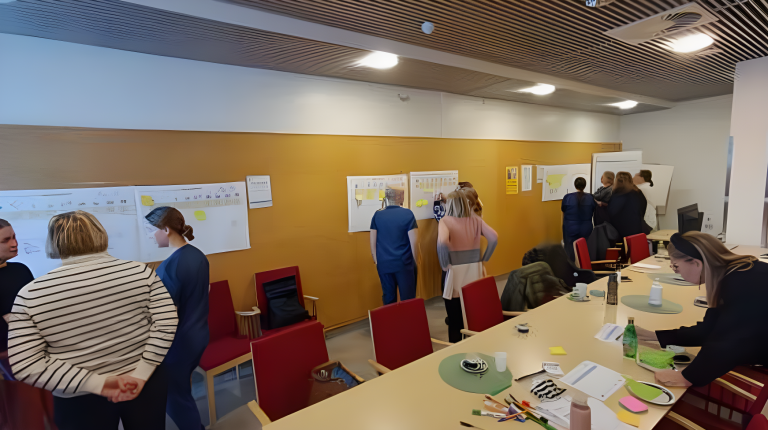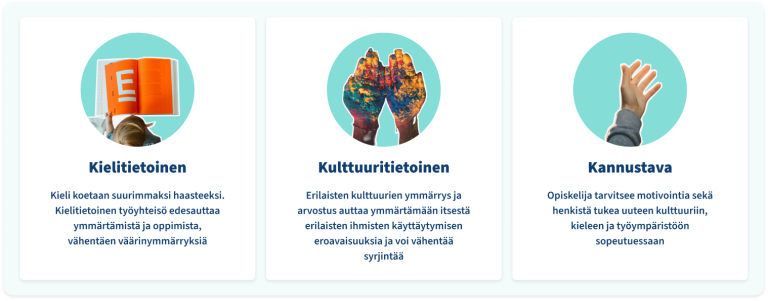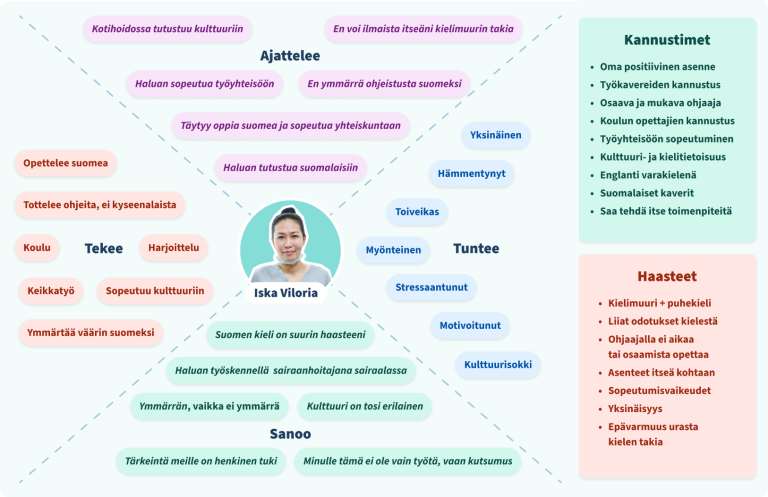Bachelor Thesis - ELMA 2.0
Investigating immigrated nurses’ employee experiences in an EU-funded initiative
Year
2023-2024
Place
LAB University of Applied Sciences, Lahti, Finland
Deliverables
- Service design
- Research
- User research
- Visualization
Project draft link
Bachelor thesis available in Theseus (in finnish)
Finding solutions for improving immigrant nurses’ employee experiences in Finland.
Finland’s healthcare is in crisis: they are running out of nurses. Organizations like Päijät-Häme Wellbeing Services County are easing the situation by recruiting nurses from abroad. However, it appears that moving to work halfway across the world isn’t all that easy, and these foreign nurses face a plethora of issues in their new professional, and personal, life.
I got to play a role in the European Union -funded project, Elma 2.0, as a thesis worker and a Service Designer intern simultaneously. As the result was a highly-rated thesis paper, which proposes the nursing instructor’s role to be improved for enchanced employee experiences.
Overview
”Without any prior knowledge or experience from the healthcare industry or immigration challenges, approaching this complex network of issues was a true challenge. Through explorative and qualitative research I dove deep into the topic. Trying not to get sidetracked by my curiosity, I explored the topic holistically and comperehensively. This case study is only scratching the surface, and I highly recommend browsing through the thesis paper for more insights.
Thoughts on the project
Laying the foundation
Crisis at hand
Nearly 90% of nurses in Finland have considered changing career after the Covid-pandemic, data shows. Meanwhile the population is aging, resulting in more people to be treated. This creates a vicious cycle, where the workload of each nurse left is only increasing as they cover their ex-colleagues’ duties while handling the surge of new customers.
Easing actions taken
At least as a temporary solution, organizations are recruiting healthcare talent from countries like Filippines. While legistlative troubles have eased throughout the years, foreign nurses still face various issues in their new workplaces, working with a new culture and new language, which my study explored.
Important numbers
To bring the issues into concretion, here are some key facts and statistics about the topic.
These numbers highlight the supply and demand of the care-needing aging population and nurses needed to provide care.
Extra nurses needed in Finland by 2040
200 000
Process overview
Timeline
The project started in December with defining the subject and getting to know the ELMA 2.0 iniative.
In January started the user research with the interviews of 16 members of the focus group, and two workshops held for healthcare staff from different organizations within the Päijät-Häme region. January also saw the beginning of writing the thesis and doing a literary review.
February was spent mostly focusing on making sense of the data, researching the topic and its by-products, and writing. March again included the interviews, and their analysis, of four of the initiative employees, including a Finnish-language teacher, the project manager, and the lead service designer.
In April was the three-day design sprint event, which I assisted planning, and in which I facilitated my own three-day workshop. April was also the time of the actual design part of the process, where I locked in the design drivers, and with their guidance I created the visual summaries of the student’s empathy map, and the user persona of a dream instructor. May was spent wrapping up the project and finally submitting it.
Honest reflection on the process
This was my first academic and solo design project of this scale. After my initial plan to redesign the government’s psychotherapy portal fell through, I started late with ELMA 2.0. Understanding its complexities took time, and researching side effects, while insightful, delayed my progress.
Looking back, I should have begun the design process and interviews earlier. The design ended up being more a summary of my findings, with limited iteration based on expert feedback.
Actually thanks to the detours, I discovered relevant theories like Leininger’s transcultural care, which led me to blend service design and transcultural care into a new approach, “transcultural service design.” Overall this project gave me invaluable insights into healthcare and helped me grow tremendously as both a designer and researcher.
Familiarizing myself with the people
In order to understand the foreign nurses’ needs, as well as the work communities’, I conducted user research together with the experts of ELMA 2.0. This included interviews of 16 members of the target group, and two workshops for healthcare staff.
In addition, ELMA 2.0 organized an interdisciplinary design sprint, “Sote-sprint”, which I participated designing. During this three-day event, I planned and facilitated my own workshop for six of the foreign nurses, with the assistance of a co-facilitating design student.
Thinks (Ajattelee)
- Wants to adapt to the work environment.
- Must learn Finnish and adapt to society.
- Wants to meet Finns but feels she can’t express herself due to language barriers.
- Doesn’t understand instructions in Finnish.
Says (Sanoo)
- Finnish language is her biggest challenge.
- Wants to work as a nurse.
- The most important support is emotional.
- Feels nursing is her calling, not just a job.
Feels (Tuntee)
- Lonely, confused, but also hopeful and motivated.
- Positive yet stressed, experiencing culture shock.
Does (Tekee)
- Attends school and internship.
- Works in temporary jobs and adapts to the culture.
- Follows instructions without questioning them.
- Sometimes misunderstands Finnish.
Interviews
16 members of the target group – Philippino nursing students – participated in the user interviews. These interviews were conducted by an employee of the ELMA 2.0 initiative, a teacher who already had a personal connection with the students. For some of the more sensitive interviewees, a stranger participating in the situation could have caused them to be more reserved. Thus participated live as an observer to the interviews recommended by the teacher, and watched the rest as recordings.
In analyzing the results, I explored and familiarized myself with different tools for future reference.
Transcription
After trying transcribing manually and with different AI-powered (privacy-respecting) tools, I concluded that a combination of both was the most effective way. AI did a good job, but not perfect. It did provide a template of its best guesses, which I then manually corrected while watching the recording. In the transcripts I also made note of any emotions the interviewee expressed, as they might change the message’s meaning, which the transcript’s reader wouldn’t otherwise know.
Analysis
Coding the transcripts was done both manually and with different coding softwares. Thematic analysis was performed in a simple whiteboard software, where AI-assisted sorting was used.
Categories for the thematic analysis came to be: School, work, language, and culture. Additional categories were Attitudes, and Suggestions for improvement.
Workshops for healthcare staff

Two workshops for local nurses and healthcare staff were organized. I participated in designing the workshops which was mainly done by the ELMA 2.0 employees, and as a co-facilitator in running the workshops. The first one was held in a hospital’s premises, while the other took place at the LAB campus.
The run-through was simple. Participants were divided in to groups and their task was to identify challenges that a foreign nurse would go through in everyday situations. In the second workshop they then brainstormed solutions for these challenges.
As a co-facilitator I made notes of the groups’ discussions, since not everything they discussed ended up in the sticky notes but some parts were still very insightful.
Sote-Sprint 3-day workshop for students
For the “Sote-sprint” design sprint event I designed and facilitated a three-day workshop. Participants were six Philippino nursing students, whom I had been studying throughout the project, plus one design student as a co-facilitator.
I put the participants through many different activities each day, starting with icebreakers to get comfortable, moving to collaborative doodling to unleash their creativity, and ending up with concept development.
As the final result were two storyboards of improved user journeys: one for the mentors, and one for the students.
Mentee's improved experience
- The student is confused, and struggles with communication with the instructor, language skills and hurry at work
- An idea for a better mentee training arises
- The student attends a seminar where he/she is taught useful skills and Finnish culture. He receives a visual dictionary with useful finnish words and phrases supported by relevant images, and continues to study independtly on a self-study platform. Results get measured and, if needed, the student can be assigned additional training
- The student communicates better with colleagues and patients. In case of need, the student will go back for a refresher course
- Everyone – the mentee, mentor, and patients – is satisfied!
Instructor's improved experience
- The student is confused, and struggles with communication with the instructor, language skills and hurry at work
- An idea for an improved instructor training comes up
- The instructor attends a seminar to learn new skills to become better and
become a better and more culturally aware instructor - The instructor is still learning independently in the workplace through a self-learning platform
- The instructor introduces visualised word cards to facilitate communication with the student
with the student - Feedback on the instructor’s performance will be collected through a multi-channel approach – an email survey, a smiley-face meter and feedback interviews
- A supervisor who has given good enough feedback is recognised in some way, e.g. by a feedback system.
restaurant gift card - The director receives a small bonus on his/her salary for his/her extra work (not too much, however, so that
(not too much to make people want to be a director for the salary alone)
11. the director, students and patients live happily ever after
Using the Medical Flash Dictionary™
- The tutor instructs the student
- The student does not understand, resulting in confusion and boredom
- The instructor gets an idea of a visual dictionary
- The Medical Flash Dictionary is introduced
- The instructor shows a word from the dictionary in English and Finnish, supported by a picture above the word – the student understands and learns the Finnish word, whereas the mentor learns the word in English. Win-win!
- The student successfully completes the guided task and is happy
Design drivers

- Language-Aware: Based on the difficulties with language and communication, this driver highlights the importance of understanding language in the workplace. It helps both Finnish and non-Finnish speakers get along better, reducing misunderstandings, thus improving patient safety and work efficiency.
- Culturally-Aware: Sourcing from cultural differences at the workplace, this driver focuses on the need for better cultural understanding. Being more aware of each other’s cultures helps create a more welcoming and cooperative work environment.
- Supportive: This driver arises from the emotional struggles foreign nurses meet. Mentors and colleagues play a big role in supporting the immigrant nurses, making them feel safe and motivating them, making it easier for them to prosper in their new jobs.
What came out of it
From the research it appeared that the nursing instructor has the potential to make or break a nurse’s employee experience. Thus, the proposed solution focused on improving the interaction between the new nurse and their instructor.
Dream Instructor's profile
Based on all the negative and positive experiences shared in the research a sort of a model for training or evaluating nursing instructors. This took the shape of an “user persona”, which is a visual representation of the intructor’s desired qualities.
Elmo, the Supportive Mentor
Role: Ward Manager, Nurse Educator
Skills: Elmo excels in cultural awareness, mediation, and teaching, with a strong focus on creating an inclusive, multicultural work environment. His language skills include plain Finnish (Selkosuomi) and English, allowing him to bridge communication gaps effectively.
Personality: An approachable extrovert, Elmo is empathetic, friendly, and always willing to help. He encourages learning and fosters self-confidence by giving constructive feedback.
Key Goals:
- Support students in integrating into the workplace.
- Build a culturally competent team.
- Encourage a welcoming and supportive community at work.
Frustrations:
- Lack of time and recognition for additional responsibilities.
- When students are unmotivated or don’t follow guidelines.
- Resistance from the wider team to accept new employees.
This persona reflects the critical role mentors like Elmo play in ensuring a diverse and inclusive workplace, especially in healthcare settings where cultural competency is crucial for improving team dynamics and patient care outcomes.


